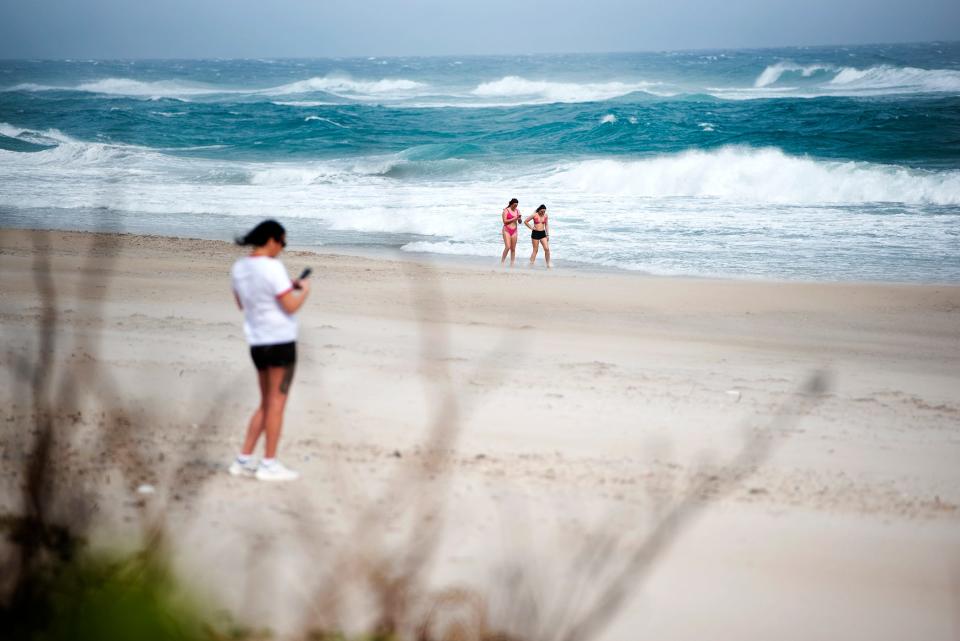Palm Beach seeks federal money for Midtown Beach project, but access could stall progress
Editor's Note: This story was updated to reflect the correct locations of the 11 privately owned parcels.
The federal government could fully cover the cost to replenish Palm Beach’s Midtown Beach — but the town staff first must figure out how to handle 11 beachfront parcels that have not granted perpetual easements that would allow the work to be done.
In a presentation to the Town Council during the Jan. 9 meeting, town engineer Patricia Strayer said the U.S. Army Corps of Engineers approved and would pay 100% of the cost to replenish sand on Midtown Beach lost to erosion caused by Hurricane Nicole in November 2022. The work would be paid for under the Flood Control and Coastal Emergencies Act, Strayer said.

But the Army Corps told the town that the project cannot move forward because Palm Beach does not have all of the easements needed along the stretch of coastline that would be included in the project, Strayer said.
Palm Beach has two options, she said: Request a variance that would allow the town to pay for sand on the portion of the project where perpetual easements have not been granted by property owners, or wait for the Army Corps to complete a new report with recommendations for the coastline excluding those 11 properties, which run from roughly Wells Road in the north to Sunrise Avenue in the south.
The entire project is from about Casa Bendita south to Gulfstream Road.
If the work can move forward with the town paying for a share, then the renourishment project should be able to begin in November, Strayer said. If not, it could push back the timeline another year.
"We've put off the seawall to November 2026," Strayer said, referring to a project that would rehabilitate the seawall along Midtown Beach. "We need to keep sand in front of our Midtown Beach, and this is 100% federal cost."
Working in the town's favor is the erosion control line, which is supported by state law, so the state will be able to grant any easements on the water side of that line, Strayer said.
The town would only be able to pay for sand on the 11 parcels if Palm Beach is able to get construction easements from those property owners to proceed with the work, she said. The Water Resources Development Act of 1986 includes a provision that allows local sponsors of federal erosion work to pay some of the cost of the project, if it benefits private property owners farther from the shore, or "upland."
If the construction easements are granted, then the town could pay for any work on the land side of the Erosion Control Line, and the Army Corps would pay for work on the water side, Strayer said.
Cooperation from those owners could prove especially tricky: The town is engaged in litigation with several related to past beach work and who has access once publicly paid-for sand is placed on a private beach.
One argument being made by some of the property owners is against the town's assertion that once sand is added, that addition is "subject to a public easement for traditional uses of the sandy beach," town attorney Joanne O’Connor said. "So these homeowners in this area have sued the town, saying, 'No, no, no. We think it's completely private.' "
Those 11 properties create what is essentially "a break in the chain," where the project cannot continue as planned, Public Works Director Paul Brazil told the council.
While those property owners were reluctant to sign a perpetual easement because of the public beach access, they may be more inclined to sign a construction easement to let the Army Corps proceed with the project, Brazil said.
"Whatever we do, I don't want to punish those people that are trying to play ball with us on this," said council President Pro-tem Bobbie Lindsay.
"The purpose of this project is to provide shore protection, not just for the adjacent property owner," Brazil said, referring to those properties that are considered upland, or not directly on the coast.
No vote was taken on the project, but the council did express support for the town staff to pursue a path that would get sand flowing onto Midtown Beach before the end of this year.
"If we want the sand, which we do for our protection, in November 2024, we have to kind of accept, although this is undesirable, that we have to pay more for sand in that certain area in order for the whole project to move forward," Town Manager Kirk Blouin told the council.
"If we don't, then all these people to the south, they won't get the sand either. So we try not to cut out nose off to spite our face, even though we're not happy with the current situation."
While the town navigates this issue, staff members also are working with the Army Corps to possibly create a new set of rules for future projects, Blouin said.
The budget for the federal portion of the project is about $20 million, with the cost for the town to be determined, Strayer said.
Kristina Webb is a reporter for Palm Beach Daily News, part of the USA TODAY Florida Network. You can reach her at kwebb@pbdailynews.com. Subscribe today to support our journalism.
This article originally appeared on Palm Beach Daily News: Private parcels slow Palm Beach push for federal cash for erosion fix

